#Vue 3.0 typescript
Explore tagged Tumblr posts
Text
Angular Vs. ReactJs Vs. VueJs
The popularity of front-end frameworks is rapidly increasing as they allow developers to build more complex and reliable applications in a minimum time and effort. The web development industry has been transformed by these innovative technologies.
Choosing the right front-end development framework that meets your unique business needs- is a challenging task for every business owner. There are tons of reasons for the pros and cons of each framework, and you'll probably end up back at square one if you try to weigh the pros and cons of each.
Being the oldest front-end framework, Angular is considered the most comprehensive. Or, should you opt for React because React is the most loved framework by many people, and they cannot be wrong at all? Talking about Vue.js, it is younger in the market and going to appear better than the other two.
Well, in this article, we will be talking about the three most popular front-end technologies: Angular, ReactJS, and Vue.js, and we will cover each framework so that you can determine which one best suits your needs.
Let’s get started!
What is Angular?
Angular, developed by Google, was released in 2010 and is a TypeScript-based JavaScript framework. In 2016, Angular 2 (the first release of Angular 2 without the “JS” in its name – AngularJS) represented a shift in positioning and direction from the original AngularJS.
Version 2+ of Angular is just Angular, and although AngularJS (1 version) continues to get updates, we'll talk mainly about Angular, and the most recent version is Angular 13, which was released on November 03, 2021.
There are many top-notch features available with the Angular framework, including control of the user interface, handling user input, validating forms, routing, state management, testing, PWA capabilities, and more. Unlike React, Angular offers a complete collection of framework capabilities.
What is Vue.js?
In 2014, Evan You developed Vue, especially after leaving his job at Google. Although no large company has endorsed Vue, it has seen substantial growth over the past three years.
Contributors for Vue are supported by Patreon, and Vue 3 is currently located in its own GitHub repository; it is run using TypeScript. The current stable version of Vue is 3.0, released in September 2020 (with a few smaller incremental releases since then).
There are more tools in Vue compared to React, but fewer than Angular. It comes with state management and a router but does not offer HTTP client functionality or form validation features.
It makes use of the virtual DOM to ensure faster and bug-free performance. Vue mainly focuses on creating user interfaces and reusable components compared to the other two.
What is React?
Facebook developed React in 2013; React is heavily used by Facebook's products such as Facebook, WhatsApp, and Instagram. The most current stable version is 17.0.2, released in March 2021 and the latest one is also on the headline.
In React, you can create components and subcomponents, which you can think of as UI pieces on a website. One key functionality is building components and subcomponents.
You can also use React to define how your components are rendered and to build SPAs that don't need to refresh the browser, thanks to third-party packages like React Router, a dynamic, non-refreshing routing library.
Overview of Advantages and Limitations
It can be difficult to decide what technology framework to use. The fact is, you cannot pick the best. Each framework has different strengths and weaknesses, so ultimately it depends on your business needs.
There are many factors to consider when choosing a framework, which we will discuss here. However, the most important thing is to choose the framework that you love the most seeing your business's profitability.
Advantages of React JS
A lightweight JS framework with a simple syntax that combines HTML and JavaScript, making it easy to learn. Documentation is readily available, which is a plus for beginners.
Provides excellent support for PWA (progressive web app) especially when you create-react-app templates.
It offers Virtual DOM implementation and rendering optimizations which makes it extremely fast.
Using functional programming with components, react creates modularized code that can be reused, resulting in easier maintenance and scaling. Apps can be developed more easily and scaled with more scalable infrastructure.
Limitations
There have been constant changes in React technology, which makes it a bit challenging to keep up with the latest documentation.
Developers can make design choices freely since React technology is unopinionated.
React utilizes JSX, which creates a learning barrier for some developers, despite its benefits.
Advantages of Angular
Angular makes use of TypeScript, which provides great support for type checking and other external tooling.
Google provides support for Angular, so it can be said that it is a trustworthy framework.
They offer detailed documentation with a huge community, which makes it easier to learn.
Autocomplete is supported inside external HTML templates for components in Angular, allowing for faster development times.
Limitations
There is a slowdown in performance due to the real DOM used, but this can be remedied with the use of ChangeDetectionStrategy, which assists in writing manual code.
Angular offers a comprehensive range of structures including various modules, components, pipes, etc., which makes it hard to learn this framework compared to React and Vue, which mainly rely on the components.
Advantages of Vue.js
Vue comes with detailed documentation, which helps developers overcome their learning curve. With just a basic knowledge of HTML and JavaScript, developers can construct powerful single-page applications.
Vue is used to design robust single-page web applications.
Vue has a smaller footprint, so its speed and flexibility are optimal, which gives better performance compared to other frameworks.
It can be integrated easily with existing infrastructure without having any impact on the system.
Vue uses virtual DOM, which makes it faster than Angular.
Limitations
As a relatively new technology with a tiny market share, Vue has fewer resources than React and Angular, meaning that support and knowledge sharing are less common.
How to Choose the Right Javascript Framework for your Project?
It remains to be answered - when are the three frameworks to be chosen? Which benefits should be exploited to the maximum? We have listed the following criteria that can help you make the right decision regarding the most appropriate platform for your project based on the major advantages and disadvantages of each framework:
Choose Angular:
When you want to create a large and complex project such as building enterprise applications with Angular
When you are looking for simplicity
When you want great reliability and scalability
When you have Angular developers on your team
When you can afford some time to learn TypeScript before the project starts
Choose React:
When your project can accept reusable components
When your project’s front end is not too complex
When your performance and scalability are important
When you are having tight deadlines
When you are looking for relevant experience in React.js development.
Choose Vue.js:
When your project scope is on the small side
When you want superior performance
When you have experienced front-end developers but have team members with JavaScript knowledge
When you are not experienced in learning a new technology
Angular, React, and Vue.js are by no means the only front-end frameworks available. There are a lot of exciting tools that will suit projects of different sizes and complexity.
It shouldn't be hard to put together the right technology stack and deliver a great software solution with the right approach and common sense.
JavaScript-based tools are available along with front-end development frameworks. You can always count on us for any development team you need to hire, such as a React.js developer team for example.
Let’s make a detailed comparison between Angular Vs. ReactJs Vs VueJs one by one:
Angular Vs. ReactJs Vs VueJs: Framework Size
Size matters for development frameworks since size influences application performance. Angular is one of the heaviest in size, with 143k. A framework and its application must be downloaded before an application can be used.
The second most popular framework is React, with a size of 43k, and the lightest framework is Vue.js, with only 23k. Therefore, if your application is not more complex and doesn’t have many sophisticated components, choosing the smaller framework would be the best option.
Angular Vs. ReactJs Vs VueJs: Performance
It is important to know that Web application performance directly depends on the Document Object Model, or DOM, which represents a web page in both the browser and in the source code. The DOM is what allows web pages to be modified during an update process.
When only one item is changed on a web page, Angular updates the entire page and re-renders the whole web page. Regular DOM, particularly in single-page applications, affects performance, making it its Achilles' heel.
As both React and Vue.js make use of virtual DOM, they leave Angular in the dust. Changes can be made in a copy of the DOM without affecting the actual DOM. In addition, just the modified components of the virtual DOM are rerendered, and the updated virtual DOM is compared to a snapshot of the regular DOM. The performance of the application is greatly improved by this approach.
Angular Vs. ReactJs Vs VueJs: Community
React was rated the most popular framework for developers in the 2017 Stack Overflow Developer Survey. The app enjoyed unparalleled popularity and support because it was constructed by the Facebook team. With more than thirty thousand developer members now contributing to React's development, its developer community has now exceeded thirty thousand members.
Traditional users have appreciated the advantages of Angular and the community has been quite supportive. Even with the statistics by Bestof.js showing AngularJS still has a lot more followers than its later versions, the first version of Angular still has many more followers.
Although Vue.js has many advantages, it doesn't appear to be popular with developers despite its advantages. Collaboration on framework functionality improves the framework's functionality and, more importantly, its library collection expands.
The components in React are sure to be reusable since they have been contributed by peers. In other words, React might be your best option if you are looking for community support and ready-made components.
Angular Vs. ReactJs Vs VueJs: Popularity
Google Trends provides little insight into the popularity of "angular" and "react" since they are frequently used terms. However, the number of stars they receive on their GitHub repo is a good barometer of their popularity.
Recently, Vue has been up there with React among the top frameworks. After a sudden drop in stars in mid-2016, it is back on top. Your development team will be able to overcome the shortcomings of these frameworks, regardless of which business framework you use.
If the team is in the right hands, it can be assured that this will happen. Moreover, your developers are experts and understand these frameworks inside and out, so you can always rely on them to deliver the solutions you need.
Or you can hire dedicated developers who are proficient in Vue.js, React, and Angular from a reputable company.
Angular Vs. ReactJs Vs VueJs: Scalability
The ability to maintain an expanding functionality is the essence of scalability as it applies to front-end development. A development platform should be able to support the growth of applications as they grow in size and complexity.
Both Angular and React are easily scalable when it comes to building scalable applications, according to developers almost unanimously. Modular development with Angular provides scalability, while component-based development with React yields excellent results.
Because it uses template-based syntax, Vue.js has a disastrous record when it comes to scalability. It becomes increasingly difficult to reuse templates within a large application, compared with JavaScript components.
Angular Vs. ReactJs Vs VueJs: Learning Curve
It is very subjective that for some people technology A may be easier to learn than technology B; while others may find it difficult to learn. Having mastered JavaScript and understanding its concepts is the first step to learning the front end, so all three should be equally easy for you.
Because Typescript is good to know when writing Angular apps (despite it not being required), it may cause more problems with Angular. React.js and VueJS appear to be more accessible to beginners than other frameworks, according to my research. However, individual preferences play a large role here.
Angular Vs. ReactJs Vs VueJs: User Friendliness
Angular, React, and Vue.js are the three most difficult technologies in that order. As a result, Vue.js has an advantage. It is easy for organizations to hire and onboard experienced JS developers, and also want to make them work seamlessly with Vue.js.
Angular Vs. ReactJs Vs VueJs: Popular Projects
Now we would like to sum up this article with this final point, describing some well-known projects that have utilized each of these frameworks, illustrating that you can accomplish big things no matter what the technology is.
Netflix, Facebook, and Instagram are some of the most popular websites using Angular. React.js powers more popular websites including Forbes, BMW Price calculator, Santander Bank, etc. Some of the leading names like Alibaba, 9GAG, and FontAwesome are powered by Vue.js.
Final thoughts
The major components of these frameworks are under continuous development, and new versions are released regularly as well as maintenance of existing ones. Since all of these frameworks have a high level of support, you can use them all safely. In contrast, Vue - which started more recently but is still growing quickly - is not growing as fast as Angular.
It is impossible to say which frameworks will be relevant in the long run, but each project is backed by a great community, and each is continually evolving. It's important to take a few things into account before jumping into a new framework. First, the expertise of your team can play a big role in choosing a new technology.
Hiring dedicated developers for your project from a leading custom web development company can also help. Lastly, your choice of framework may also be affected by the complexity and scope of the project itself. You can use this information to decide which front-end framework is best for your needs and goals by taking into account all the key differences.
0 notes
Text
Hire dedicated vuejs developer
Wama Software Provide Hire Dedicated vue.js Developer, hire vuejs developer Services in India. Since leaders are always trendsetters, let’s consider the latest updates in Vue, which will affect the trend of web development:
Increased productivity: This option is achieved by using a template compiler developed and improved for fast rendering of static content.
Suitability for larger projects: Vue 3.0 made the framework attractive to larger teams. No more performance delays, just improved readability.
Compatible with TypeScript: That is a great advantage. As with JavaScript, TypeScript has a similar syntax. Using TypeScript, you can compile any Javascript code you write. TypeScript can be added to a Javascript project already in development.
Shifting in architecture: Vue’s internal structure was changed to a set of individual modules. The new architecture provides better support and allows end users to reduce the execution time to half by Creating your own UI libraries: The defined custom element method allows users to create personalized solutions based on Vue’s component APIs.
Generally, Vue.js developers should conduct the following duties:
Develops the architecture of the components and the structure of the project.
Creates interactive and dynamic sites – adds content, sliders, animations, pop-up windows.
Adapts web pages to different browsers, desktops, and mobile devices.
Tests code, searches and fixes bugs, optimize already running service and maintains it in working condition.
Cooperates with other specialists from the team.
Remember to clearly define your project requirements, company culture, and expectations to attract the right candidates. Additionally, offering competitive compensation and benefits can make your job posting more appealing to potential Vue.js developers. For more information visit us wamasoftware
0 notes
Photo
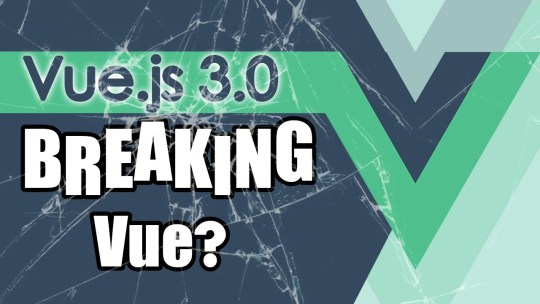
Is Vue.js 3.0 Breaking Vue? Vue 3.0 Preview! Vue 3.0 is in RFC mode right now. But what does it change? In this video I discuss the changes in Vue 3.0 and you can see what breaking changes there is! source
#Breaking#Erik Hanchett#evan you#Evan you Vue.js#Preview#Program With Eric#Program With Erik#vue#Vue 2019#Vue 3#Vue 3 breaking changes#Vue 3 preview#Vue 3 Preview 2019#Vue 3 RFC#Vue 3 Setup#Vue 3 vs Vue 2#Vue 3.0 Evan#Vue 3.0 typescript#vue js#vue js 2019#Vue.js 3 tutorial#Vue.js 3.0#Vue.js 3.0 RFC#vuejs#What is the changes in Vue 3
0 notes
Text
Top Features of the Latest Version of Vue.js Framework | Copperchips
The latest version of Vue.js framework was released on September 18, 2021. This Vue.js 3.0 is a result of months of planning and efforts. This planned upgrade of the Javascript framework is utilized for building a web user interface. This novel version of Vue.js has etched its place in the market as well in the hearts of many developers. Let us see through this article, what were the initial expectations of the Vue.js developers and if the latest version stands up to their standards.
Vue.js 3.0 Features

In the past few years, there have been changes in the landscape of Vue.js framework development. Its community has evolved from a small upstart to a fully-fledged SPA library. With version 3.0 on the brim of Vue.js framework, the team of developers has provided few supports to augment the library, simplify coding on Vue, and adopt modern techniques of web development.
Let us dive into the technicalities of the latest version of Vue.js framework.
Composition API
The components included in Vue.js framework version 2.0 were created with the object-based options API. One of the novel features of the latest version of Vue.js framework is that it has added a set of function-based APIs that are called Composition API. These APIs have been added to confront issues faced by Vue.js 2.0 for large projects.
The composition API is the root cause of controversy for the Vue community. It can be seen as a novel way of developing components. The composition API need not be installed like a plug-in like before. Instead, it can be used without any additional setup as it is built-in within the package.
The community of Vue.js Developers formulated a composition API to enhance the quality of the code by enabling decoupling features of the logic. In contrast to Vue.js framework version, where developers rely on extending the object and then sharing logic, Vue.js framework version 3.0 enables sharing features via standard JavaScript/TypeScript patterns instead of inventive novel ones. This facilitates seeing the new features as they get added. Additionally, the Composition API makes it easier for the types to infer, which supports the typescript in a better way.
Vue.js version 3.0 allows Vue.js developers to build components along with allowing the new API to co-exist with the Options API, without replacing it. Composition API equips Vue.js developers with more flexible code organization and logic reuse capabilities along with other improvements. With Composition API, Vue.js developers can easily read the codes and organize the code in a better way.
Enhanced TypeScript Support
With the coming of Composition API, the internal functions of Vue.js framework are used as expected in javascript, which allows for much better TypeScript support. It results in enhanced type inferences with bindings returned from setup along with props declaration used to infer types.
TypeScript assists in enhancing the maintainability of the Vue codebase and makes it easier for Vue.js developers to contribute. TypeScript is the most popular and frequent choice for large projects. Having Vue.js framework version 3.0 internals in TypeScript assists in benefiting fully from Vue’s TypeScript with the usual code support available in modern IDEs such as Visual Studio Code, or WebStorm. Since TypeScript’s Vue code is 90% JavaScript, The users of JavaScript also benefit from code intelligence features with contemporary IDEs.
Reactivity
In Vue.js framework version 2.0, the reactivity worked in a secretive way and it wasn’t exposed to the developer. The hidden details added to the confusion more than they should have. The latest Vue.js framework came to the rescue by supporting many ways of wrapping objects to ensure that they are reactive. Now, they can be wrapped with a ref function for scalar types. This assists in reading and writing the property directly with .value.
READ MORE
SOURCE: COPPERCHIPS
#copperchips#vuejsdevelopment#vuejsframwork#vuejs#vuejsdevelopers#customsoftwaredevelopment#customsoftware#softwaredevelopment#webdevelopment#itservices#itsolutions
0 notes
Photo

Revisiting 'funny' and tricky JavaScript examples
#513 — November 6, 2020
Unsubscribe | Read on the Web
JavaScript Weekly

What's the Deal with Svelte and SvelteKit? — Two weeks ago we linked to a video where Svelte’s creator pondered the future of Web development. Now here’s a more definitive writeup of what you need to know about how Svelte is progressing.
Rich Harris (Svelte)
BTW, if Svelte is your thing, Svelte Radio is a frequent podcast covering developments in the space. There's also an official Svelte November 2020 update.
WTFJS: A List of Funny and Tricky JavaScript Examples — This has been around for a few years but continues to get tweaks and adjustments and if you’ve not seen it, it’s worth a look to get a deeper look into some of the more “uh, what?” corners of JavaScript.
Denys Dovhan
Vue 3 Is Out! Jump into Vue 3 Quickly in This New Course by Sarah Drasner — Learn fundamental concepts in Vue, such as directives, methods, and computed watchers. You’ll learn Vue’s reactivity system and the new Composition API in Vue 3.
Frontend Masters sponsor
New, Core 'Redux Fundamentals' Tutorial — A complete rewrite of the official Redux introductory tutorial that covers both how Redux works and how to use it. Say goodbye to outdated terminology and hello to modern practices and code sandbox demos. Easy to skim even if Redux isn’t your cup of tea.
Redux Core Team
Socket.io 3.0 Released: A Realtime Framework for Node and Browser — We’re awaiting a full blog post on this release, but Socket·io has been around many years and was once the ‘go to’ system for bidirectional browser/server communications that worked in almost every browser.
Socket·IO Project
⚡️ Quick bytes:
Hackaday has profiled a neat TTL logic simulator built in JavaScript.
The latest VS Code release has a new empty brace formatting option for JavaScript code (to set whether or not { } should contain a space).
SpiderBasic is a modern (and commercial) BASIC implementation that compiles to JavaScript in an attempt to take BASIC to the Web.
There's a lot of neat stuff in the Code & Tools section this week, so be sure to head down there! :-)
📚 Tutorials, Opinions and Stories
An Introduction to Data Visualization with ApexCharts — ApexCharts is an MIT-licensed interactive JavaScript charting library.
Nefe Emadamerho-Atori
Clickjacking Attacks and How to Prevent Them — A look at both client-side and server-side approaches to mitigating clickjacking attacks including some approaches for Express.js-based apps.
Andrea Chiarelli
ES Modules in Depth — An exploration of the different ways you can export and import values using ES Modules (now broadly supported in most places, even if you’re not using extra tools).
R. Alex Anderson
Stream Chat API & JavaScript SDK for Custom Chat Apps — Build real-time chat in less time. Rapidly ship in-app messaging with our highly reliable chat infrastructure.
Stream sponsor
An Introduction to FFmpeg.wasm, a WebAssembly / JS Port of FFmpeg — I think WebAssembly is going to have a huge impact over the next few years and this project, despite being in the early stages, shows off a few reasons why. Project homepage.
Jerome Wu
The JavaScript 'Self-Profiling' API — The JS Self-Profiling API is a proposed API (supported only in Canary builds of Chrome for now) for letting developers control a sampling profiler for measuring client JavaScript execution times.
Addy Osmani
Build a 'Remaining Character Count' Component with Alpine.js — Alpine.js bills itself as ‘like Tailwind for JavaScript.’
Ryan Chandler
How to Organize a Large React Application and Make It Scale Jack Franklin
Building a Type-Checked URL Router From Scratch with TypeScript 4.1+ Jan Sommer
How to Localize a Vue App with vue-i18n and Localazy Václav Hodek
▶ Fancy TypeScript Features for the Everyday Developer George Kosmidis
Top Problems I Encountered Switching from Vue 2 to Vue 3 Ghiura Alexandru
🛠 Code & Tools

SpaceTime: A Lightweight Timezone Library — Use this to calculate times in other timezones. Has a Moment-esque API but is immutable. No dependencies. We last linked this years ago but it’s still under active development. It has a neat interactive demo too.
Spencer Kelly
Graphery SVG: A Library for SVG Creation and Management — This well-documented library is good for creating and manipulating SVG in JavaScript. Offers a simple API, that’s said to be very close to the native structure of SVG.
Graphery
Square Terminal API — Connect your app to the all-in-one payments device merchants love with a simple REST API. Learn more.
Square sponsor
Dojo3D: A Library for Simple 3D Interactive Story Telling — Aimed at ‘all ages of coder’, Dojo3D tries to make creating interactive 3D stories a smooth process. There’s an online sandbox example you can play with.
Webprofusion

gron: Make JSON Greppable — A tool written in Go that transforms JSON into more easily greppable assignments, so you can use grep and see the context/path of the result. Useful.
Tom Hudson
SpanTree: Adds Tree-Based File Navigation to GitLab — A browser extension you may find useful if you browse GitLab-hosted repositories often.
Taveesh Anand
Marked: A Fast Markdown Parser and Compiler — Works in the browser or server-side. Demo here.
Christopher Jeffrey
Measure What Matters to Users, Browsers Don't Have Feelings
New Relic sponsor
μPlot 1.3: Fast, Tiny, Canvas-Based Time Series Chart Library Leon Sorokin
Fetch 3.5: A `window.fetch` Polyfill GitHub
💻 Jobs
Find a Job Through Vettery — Create a profile on Vettery to connect with hiring managers at startups and Fortune 500 companies. It's free for job-seekers.
Vettery
by via JavaScript Weekly https://ift.tt/3l7hRn9
0 notes
Text
Vue 3.0 arrives, now in TypeScript
Vue 3.0, a major upgrade to the popular JavaScript framework for building web UIs, is now available as a production release, after nearly two years in development. Highlights include better performance and smaller bundle sizes. Unveiled September 18, Vue 3.0 improves performance over Vue 2 in terms of render speed, update speed, memory usage, and…
https://is.gd/0Igw12
0 notes
Link
In 2020, we are blessed with a number of frameworks and libraries to help us with web development. But there wasn't always so much variety. Back in 2005, a new scripting language called Mocha was created by a guy named Brendan Eich. Months after being renamed to LiveScript, the name was changed again to JavaScript. Since then, JavaScript has come a long way.
In 2010, we saw the introduction of Backbone and Angular as the first JavaScript frameworks and, by 2016, 92 per cent of all websites used JavaScript. In this article, we are going to have a look at three of the main JavaScript frameworks (Angular, React and Vue) and their status heading into the next decade.
For some brilliant resources, check out our list of top web design tools, and this list of excellent user testing software, too.
01. Angular
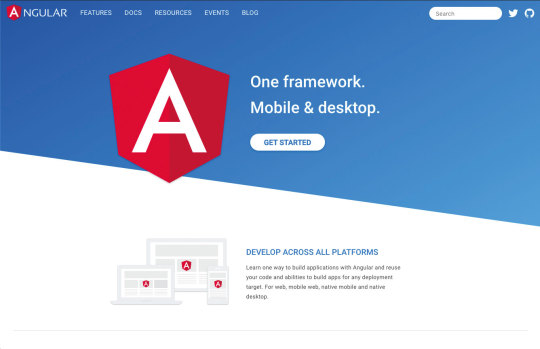
AngularJS was released in 2010 but by 2016 it was completely rewritten and released as Angular 2. Angular is a full- blown web framework developed by Google, which is used by Wix, Upwork, The Guardian, HBO and more.
Pros:
Exceptional support for TypeScript
MVVM enables developers to separate work on the same app section using the same set of data
Excellent documentation
Cons:
Has a bit of a learning curve
Migrating from an old version can be difficult.
Updates are introduced quite regularly meaning developers need to adapt to them
What's next?
In Angular 9, Ivy is the default compiler. It's been put in place to solve a lot of the issues around performance and file size. It should make applications smaller, faster and simpler.
When you compare previous versions of Angular to React and Vue, the final bundle sizes were a lot a bigger when using Angular. Ivy also makes Progressive Hydration possible, which is something the Angular team showed off at I/O 2019. Progressive Hydration uses Ivy to load progressively on the server and the client. For example, once a user begins to interact with a page, components' code along with any runtime is fetched piece by piece.
Ivy seems like the big focus going forward for Angular and the hope is to make it available for all apps. There will be an opt-out option in version 9, all the way through to Angular 10.
02. React

React was initially released in 2013 by Facebook and is used for building interactive web interfaces. It is used by Netflix, Dropbox, PayPal and Uber to name a few.
Pros:
React uses the virtual DOM, which has a positive impact on performance
JSX is easy to write
Updates don't compromise stability
Cons:
One of the main setbacks is needing third-party libraries to create more complex apps
Developers are left in the dark on the best way to develop
What's next?
At React Conf 2019, the React team touched on a number of things they have been working on. The first is Selective Hydration, which is where React will pause whatever it's working on in order to prioritise the components that the user is interacting with. As the user goes to interact with a particular section, that area will be hydrated. The team has also been working on Suspense, which is React's system for orchestrating the loading of code, data and images. This enables components to wait for something before they render.
Both Selective Hydration and Suspense are made possible by Concurrent Mode, which enables apps to be more responsive by giving React the ability to enter large blocks of lower priority work in order to focus on something that's a higher priority, like responding to user input. The team also mentioned accessibility as another area they have been looking at, by focusing on two particular topics – managing focus and input interfaces.
03. Vue
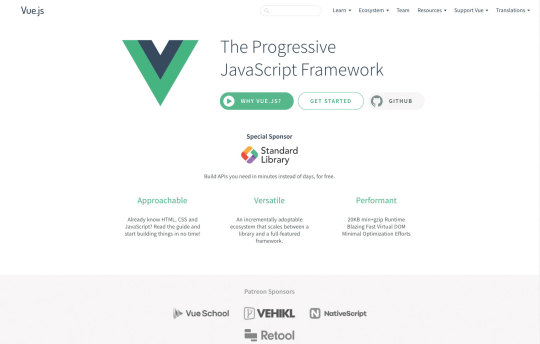
Vue was developed in 2014 by Evan You, an ex-Google employee. It is used by Xiaomi, Alibaba and GitLab. Vue managed to gain popularity and support from developers in a short space of time and without the backing of a major brand.
Pros:
Very light in size
Beginner friendly – easy to learn
Great community
Cons:
Not backed by a huge company, like React with Facebook and Angular with Google
No real structure
What's next?
Vue has set itself the target of being faster, smaller, more maintainable and making it easier for developers to target native. The next release (3.0) is due in Q1 2020, which includes a virtual DOM rewrite for better performance along with improved TypeScript Support. There is also the addition of the Composition API, which provides developers with a new way to create components and organise them by feature instead of operation.
Those developing Vue have also been busy working on Suspense, which suspends your component rendering and renders a fallback component until a condition is met.
One of the great things with Vue's updates is they sustain backward compatibility. They don't want you to break your old Vue projects. We saw this in the migration from 1.0 to 2.0 where 90 per cent of the API was the same.
How does the syntax of frameworks compare?
All three frameworks have undergone changes since their releases but one thing that's critical to understand is the syntax and how it differs. Let's have a look at how the syntax compares when it comes to simple event binding:
Vue: The v-on directive is used to attach event listeners that invoke methods on Vue instances. Directives are prefixed with v- in order to indicate that they are special attributes provided by Vue and apply special reactive behaviour to the rendered DOM. Event handlers can be provided either inline or as the name of the method.
React: React puts mark up and logic in JS and JSX, a syntax extension to JavaScript. With JSX, the function is passed as the event handler. Handling events with React elements is very similar to handling events on DOM elements. But there are some syntactic differences; for instance, React events are named using camelCase rather than lowercase.
Angular: Event binding syntax consists of a target event name within parentheses on the left of an equal sign and a quoted template statement on the right. Alternatively, you can use the on- prefix, known as the canonical form.
Popularity and market
Let's begin by looking at an overall picture of the three frameworks in regards to the rest of the web by examining stats from W3Techs. Angular is currently used by 0.4 per cent of all websites, with a JavaScript library market share of 0.5 per cent. React is used by 0.3 per cent of all websites and a 0.4 per cent JavaScript library market share and Vue has 0.3 per cent for both. This seems quite even and you would expect to see the numbers rise.
Google trends: Over the past 12 months, React is the most popular in search terms, closely followed by Angular. Vue.js is quite a way behind; however, one thing to remember is that Vue is still young compared to the other two.
Job searches: At the time of writing, React and Angular are quite closely matched in terms of job listings on Indeed with Vue a long way behind. On LinkedIn, however, there seems to be more demand for Vue developers.
Stack Overflow: If you look at the Stack Overflow Developer Survey results for 2019, React and Vue.js are both the most loved and wanted web frameworks. Angular sits down in ninth position for most loved but third most wanted.
GitHub: Vue has the most number of stars with 153k but it has the least number of contributors (283). React on the other hand has 140k stars and 1,341 contributors. Angular only has 59.6k stars but has the highest number of contributors out of the three with 1,579.
NPM Trends: The image above shows stats for the past 12 months, where you can see React has a higher number of downloads per month compared to Angular and Vue.
Mobile app development
One main focus for the big three is mobile deployment. React has React Native, which has become a popular choice for building iOS and Android apps not just for React users but also for the wider app development community. Angular developers can use NativeScript for native apps or Ionic for hybrid mobile apps, whereas Vue developers have a choice of NativeScript or Vue Native. Because of the popularity of mobile applications, this remains a key area of investment.
Other frameworks to look out for in 2020
If you want to try something new in 2020, check out these JavaScript frameworks.
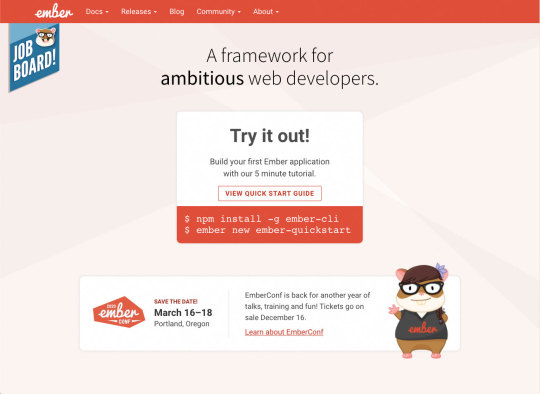
Ember: An open-source framework for building web applications that works based on the MVVM pattern. It is used by several big companies like Microsoft, Netflix and LinkedIn.
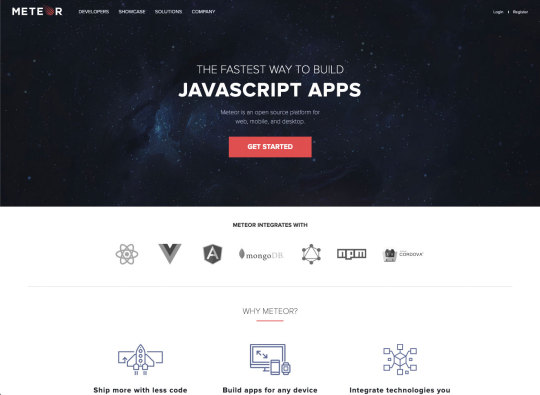
Meteor: A full-stack JavaScript platform for developing modern web and mobile applications. It's easy to learn and has a very supportive community.
Conclusion
All three frameworks are continually improving, which is an encouraging sign. Everyone has their own perspective and preferred solution about which one they should use but it really comes down to the size of the project and which makes you feel more comfortable.
The most important aspect is the continued support of their communities, so if you are planning to start a new project and have never used any of the three before, then I believe you are in safe hands with all of them. If you haven't had a chance to learn any of the three frameworks yet, then I suggest making it your New Year's resolution to start learning. The future will revolve around these three.
0 notes
Text
Beta von Vue.js 3.0 lädt zum Probieren ein
Das Upgrade soll an Geschwindigkeit zulegen und TypeScript besser unterstützen, erzeugte Dateien sind offenbar kleiner und die Update-Funktion ist überarbeitet. Read more www.heise.de/news/…... www.digital-dynasty.net/de/teamblogs/…

http://www.digital-dynasty.net/de/teamblogs/beta-von-vue-js-3-0-ladt-zum-probieren-ein
0 notes
Text
Веб-розробка 2020: за чим стежити в новому році?
Фахівці ІТ-компаній розповідають про найцікавіші інструменти, за розвитком яких варто спостерігати в 2020 році.
GraphQL

До недавнього часу найпоширенішим стилем програмної архітектури був моноліт, відповідно до якого система структурується у вигляді одного файлу, або компонента, що розгортається. Прикладом такого підходу може служити Java-додаток рівня підприємства або, наприклад, додаток з використанням популярних PHP-фреймворків (Laravel, Yii2, Symphony).
Переваги такого підходу: простота розробки, легкість внесення змін, простота тестування і розгортання, легкість масштабування - можна запустити кілька екземплярів додатка.
Але з часом у цього підходу виявився недолік. У успішних програм є схильність в��ростати з монолітної архітектури, значно збільшуючи кодову базу і складність. Додаток стає занадто великим для обслуговуванням одним розробником. Внесення змін ускладнює і без того непросту кодову базу і робить її менш зрозумілою. Поступово витрати на підтримку такого проекту ростуть, час випуску нових функциональностей збільшується. Також виникають труднощі з масштабуванням через конфлікти вимог до ресурсів різних модулів (одному потрібно більше ОЗУ, іншому ЦПУ).
Рішенням проблеми став новий підхід - мікросервіси. В останні роки великою популярністю користується підхід розбиття старих монолітних додатків на мікросервіси. Грубо це можна уявити як розбиття моноліту помодульно на безліч невеликих додатків. Такий підхід дозволив зробити можливими безперервну доставку і розгортання великих додатків. При цьому частини програми, мікросервіси, виходять невеликими, легко масштабованими і простими в обслуговуванні.
У 2018 році компанія Facebook випустила першу стабільну версію проекту GraphQL. Це мова запитів, що описує спосіб отримання даних клієнтом або сервером. За допомогою цієї технології ваш замовник може отримувати інформацію про різні сутності системи з декількох джерел (сервісів), роблячи вибірку гнучкою, а агрегацію простою.
Впровадження GraphQL може виявитися нетривіальним і трудомістким завданням, для прийняття рішення про перехід потрібна консультація досвідченого архітектора програмного забезпечення. У той же час GraphQL дозволить вирішити проблеми отримання даних з багатьох джерел інформації для різних клієнтів, дасть можливість знизити загальну кількість запитів між ними і сервером, а також зменшить кількість переданих даних за допомогою гнучких вибірок.
VUE та NEXT
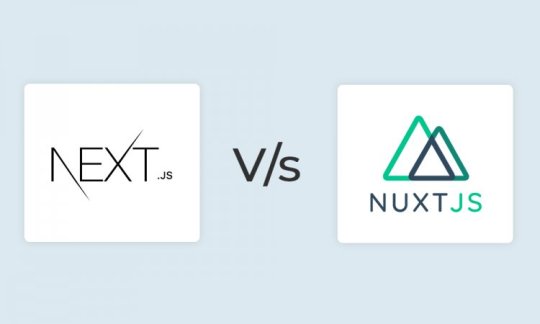
У прийдешньому році всіх фронтенд-розробників, що використовують Vue.js, очікує велика подія - реліз мажорної версії цього фреймворку. Актуальна на сьогоднішній день друга версія була випущена більше трьох років тому: з тих пір було проведено безліч невеликих змін, але прийдешній реліз виглядає як колись апгрейд Angular до другої версії.
Спробувати можливості оновленого фреймворка можна вже сьогодні: проект знаходиться в статусі Pre-alpha.
Що ж нас очікує?
Уже сьогодні в репозиторії можна побачити те, що багато хто чекав. Відсоток TypeScript коду - 96.1% !
Як можна зрозуміти з попереднього пункту, движок повністю переписаний, архітектура поліпшена, що має вплинути на перформанс - заявляється підвищення до 100%.
Нова кодова база спроектована з нуля як tree-shaking friendly. Такі функції, як вбудовані компоненти (<transition »,« keep-alive>) і директиви-помічники (v-model), тепер імпортуються на вимогу. Розмір нової runtime бібліотеки <10kb в gzip.
Vue 3.0 буде поставлятися з реалізацією паттерна Observer на основі Proxy, який забезпечує відстеження реактивності. Це дасть наступні переваги: відкритий API для створення спостережуваних об'єктів, ліниве спостереження за умовчанням. Також заплановано поліпшення можливостей налагодження: з'явиться можливість точно відслідковувати, коли і чому відбувається перемальовування компонента або запускаються нові обробники.
Фрагменти і портали: незважаючи на зменшення розміру, 3.0 поставляється з вбудованою підтримкою фрагментів (компонент, який повертає кілька кореневих вузлів) і порталів (рендеринг піддерева в іншій частині DOM, а не всередині компонента).
Для підтримки старих версій браузерів, таких як IE11, в якому немає підтримки Proxy, планується зробити окремий білд.
Підводячи підсумок, потрібно сказати, що команда Vue на чолі з Еваном Ю поставила собі дуже масштабне завдання, і вже сьогодні можна побачити, що вона відмінно з нею справляється. Нам же залишається чекати виходу стабільної версії і сподіватися, що вона дійсно буде такою швидкою і легкою, як обіцяють розробники.
WebAssembly (wasm)
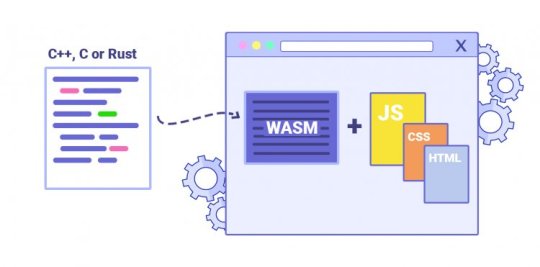
В останні роки код на фронтенді вирішує все більш і більш складні завдання, перестаючи брати на себе виключно відображення підготовлених даних. Формати даних, які доводиться обробляти на клієнті, ускладнюються. Загалом, сайти вже давно перестали бути такими, якими ми їх знали в кінці нульових-початку десятих. При цьому Javascript, який, здавалося б, уже встиг перемогти в інтернеті і Java, і Flash, і інші ActiveX, не здатний забезпечити той рівень продуктивності, який необхідний для вирішення згаданих завдань.
І тут нам на допомогу приходить технологія WebAssembly, також відома як wasm. Що це таке? По суті, це віртуальна машина, яка працює в нашому браузері. У той же час виконуваний нею байт-код працює набагато швидше, ніж код, написаний на Javascript. І хоча приріст продуктивності іноді не дуже явний, її рівень нижче, ніж у нативного коду, а технологія поки ще має низку серйозних обмежень.
Є кілька причин для того щоб стежити за WebAssembly в 2020 році і, можливо, навіть використовувати в своїх проектах. По-перше, wasm-модулі почали стабільно і добре збиратися з мов типу С, C ++ і Rust. По-друге, найближчим часом повинна з'явиться пряма підтримка основних джаваскріптових API (DOM, XmlHttpRequest та інші), потоків, повноцінний GC, що робить використання wasm ще простіше, а саму технологію більш затребуваною. По-третє, крім С і Rust можливість писати ��ід WebAssembly додається в безліч інших мов. А ще з'являються мови, які створені спеціально під wasm, наприклад, AssemblyScript. Це майже Typescript, але у нього є кілька суттєвих відмінностей: він володіє тільки найпростішими типами, в ньому немає можливості використовувати any (що дисциплінує розробників), і в цілому код на ньому пишеться в більш «низкорівневому» стилі.
0 notes
Text
Vue 3.0 for web development
Vue is a ‘progressive framework for building user applications’. It’s designed to be super flexible with the ability to either incorporate individual Vue libraries into other projects or powering complex projects entirely with Vue. So, meet Vue 3.0 for web development! Vue is often se...
#frontend#html#javascript#js#Maintainability#programming#pure HTML#software engineering#targeting#Technology#TS#typescript#Vue#vue 3.0.#vue.js#web apps#web development
0 notes
Text
Vue.js 3.0 brings more speed, more TypeScript
See on Scoop.it - Technology Innovations
Now in beta, Vue 3.0 promises significantly faster rendering in a general release by the end of June
0 notes
Text
hire dedicated vue.js developer
hire dedicated vue.js developer- Since leaders are always trendsetters, let’s consider the latest updates in Vue, which will affect the trend of web development:
Increased productivity: This option is achieved by using a template compiler developed and improved for fast rendering of static content.
Suitability for larger projects: Vue 3.0 made the framework attractive to larger teams. No more performance delays, just improved readability.
Compatible with TypeScript: That is a great advantage. As with JavaScript, TypeScript has a similar syntax. Using TypeScript, you can compile any Javascript code you write. TypeScript can be added to a
Javascript project already in development.
Shifting in architecture: Vue’s internal structure was changed to a set of individual modules. The new architecture provides better support and allows end users to reduce the execution time to half by «tree shaking».
Creating your own UI libraries: The defined custom element method allows users to create personalized solutions based on Vue’s component APIs.
Generally, Vue.js developers should conduct the following duties:
Develops the architecture of the components and the structure of the project.
Creates interactive and dynamic sites – adds content, sliders, animations, pop-up windows.
Adapts web pages to different browsers, desktops, and mobile devices.
Tests code, searches and fixes bugs, optimize already running service and maintains it in working condition.
Cooperates with other specialists from the team.
how to hire developers.
The decision of where to hire Vue.js developers depends on your project’s specific needs, budget, and timeline. You can choose one of the three options available: to engage an in-house developer, select a freelancer’s services, or contract an outsourcing company. Each option has its pros and cons, and it’s essential to carefully consider each variant.
For more information visit us our website : wama software
0 notes
Text
An Overview of What's Coming in Vue 3
At the time of this writing, Vue 3.0 is at its 10th alpha version. Expect a faster, smaller, more maintainable, and easier to use version of the Vue you know and love. You can still use Vue via a script tag and your Vue 2.x code will continue to work. But you can start playing with the alpha version of Vue 3.0 here and we’re going to get into some of what v3 is offering.
Among other things, there’s a new API for creating components. It doesn’t introduce new concepts to Vue, but rather exposes Vue’s core capabilities like creating and observing reactive state as standalone functions. This is ultimately useful to Vue developers of all levels.
Options API and Composition API
In Vue 2, components are created with the object-based Options API. Vue 3 adds a set of APIs, referred to as the Composition API, which is function-based. This is primarily to address two issues that Vue 2 ran into for very large projects.
In large components that encapsulate multiple logical tasks, you want to group code by feature, but the nature of the Options API is that such code gets split up (among lifecycle hooks and so on), negatively affecting readability. Secondly, you want to be able to reuse logic in large-scale projects, and in Vue 2, solutions like mixins don’t address either issue very well.
Vue 3 seeks to kill both birds with one stone by exposing a new API. This API will live alongside the Options API, not replace it. This means that you can go on building components in the way that you’re used to without encountering any problems. But, you can also start building with the Composition API, which provides more flexible code organization and logic reuse capabilities as well as other improvements.
Even if the problems it specifically addresses are not pertinent to you, the new API has clearly had a lot of thought go into it to push Vue forward as a framework, for instance, by reducing the extent to which Vue operates “magically” behind the scenes.
— Sorry to interrupt this program! 📺
If you're interested in learning Vue in a comprehensive and structured way, I highly recommend you try The Vue.js Master Class course by Vue School. Learning from a premium resource like that is a serious investment in yourself.
Plus, this is an affiliate link, so if you purchase the course you help Alligator.io continue to exist at the same time! 🙏
- Seb, ✌️+❤️
Composition API
The Composition API is available now as a plugin for Vue 2 so you can try it out. It will be shipped baked-in in Vue 3.
In Vue 2 reactivity was achieved through the getters and setters of Object.defineProperty. This caused some limitations which you’ve already probably experienced (e.g.: updating an Array by index). In Vue 3, reactivity is accomplished through proxies, a feature that was introduced in JavaScript ES6.
You need not have a Vue instance to use the new reactivity API. It offers standalone APIs which allow you to create, observe, and react to state changes.
You would first import { reactive } from 'vue'. Then, you could create an object in the following way:
const state = reactive({ count: 0 })
You’ll have access to APIs that will allow you to dynamically inject component lifecycle hooks into a Vue instance.
The lifecycle registration methods can only be used in the setup() method which is the entry point where all the composition functions are called. For instance:
import { onMounted } from 'vue' export default { setup() { onMounted(() => { console.log('component is mounted.') }) } }
Functions that use these APIs can be imported into a component, allowing the component to do multiple logical tasks with reusable and readable code.
TypeScript
The composition API also offers better TypeScript support. It’s supposed to result in better type inferences with bindings returned from setup() and props declarations used to infer types.
Component code using TypeScript and JavaScript will look largely identical and TypeScript definitions benefit JavaScript users as well, say, if they use an IDE like Visual Studio Code.
View Declaration
Vue 2 supports templates as well as render functions. You don’t need to know an awful lot here except that Vue 3 continues to support both while optimizing rendering speed (such as by speeding up diff algorithms that operate under the hood so that Vue knows what needs to be re-rendered).
Faster
Virtual DOM has been rewritten from the ground-up to make for faster mounting and patching.
Compile-time hints have been added to reduce runtime overhead. This means skipping unnecessary condition branches and avoiding re-renders. Static tree and static prop hoisting means entire trees and nodes can skip being patched. Inline functions (like in a handler for a component in a template) won’t cause unnecessary re-renders.
You’re going to get a proxy-based observation mechanism with full language coverage and better performance. Instance properties will be proxied faster using native Proxy instead of Object.defineProperty like before.
You can expect up to 100% faster component instance initialization with double the speed and half the memory usage. 🏎️🏎️🏎️
Smaller
Vue 3 is also smaller.
It is tree shaking-friendly. Tree shaking refers to shaking off unused code. The core runtime has gone from ~20kb in size, gzipped, to ~10kb, gzipped.
The size of the Vue bundle increases with each new feature but, by providing most global APIs and Vue helpers as ES module exports, Vue 3 makes more code tree shakeable, even template code.
Coherence
Libraries like Vue Router and test-utils will be updated to line up with the new Vue. Vue now has a custom renderer API (similar to React Native for those who want to use it to create renderers for mobile or other host environments.
Conclusion
There is a ton to look forward to with Vue 3 with more like Portals that couldn’t fit in this short post. The new Composition API moves us towards an all around better Vue. An exact release date is not set but it’s coming soon. Get a head start now!
via Alligator.io https://ift.tt/2RdfYbt
0 notes
Photo

Node 15, React 17, and a cool JavaScript demo
#511 — October 23, 2020
Unsubscribe | Read on the Web
JavaScript Weekly

React 17.0 Released — The focus in React 17 is peace, harmony, and gentle progression, with subtle changes, making apps easier to upgrade gradually in future, and also to make it easier to embed React apps into apps built with other technologies.
Dan Abramov and Rachel Nabors
Node 15 Released — The new ‘release’ line (the one that gets all the new features first) of Node is here. Two key features:
An upgrade to the V8 8.6 engine (from 8.4) adding various JS features like Promise.any(), logical assignment operators, and String.prototype.replaceAll()
Unhandled rejections are now raised as exceptions by default. If there's any one change that'll cause you some head scratching, it's this.
For more, check this week's Node Weekly ;-)
New Course: Introduction to Next.js, The Full-Stack React Framework — Next.js is a complete framework built on top of React.js. You'll learn server-side rendering, static site generation, data fetching, code API endpoints, creating pages with the file system, add CSS modules, and more.
Frontend Masters sponsor
What Vue.js Does Better Than React — “I love and use React daily but was curious if there’s anything from Vue that React could learn from. Turns out there is! This post collects my findings.”
Harry Wolff
Skypack Discover: A Way to Discover and Test Recommended JS Packages — From the same folks as the Snowpack build tool, Skypack is basically a search engine for npm packages, but it’s added a ‘Discover’ feature which helps you pick the best options for you. You can then import them ES module style.
Fred K. Schott
⚡️ Quick bytes:
Want to see something cool? MONOSPACE is a demo (in the 'demoscene' sense) written in 1021 bytes of JavaScript and it won the 1024 byte demo competition at Assembly 2020.
Rich Harris (of Svelte fame) has shared a video exploring his thoughts on the future of Web development and where the Sapper Svelte-based framework slots in (or doesn't!) — Cool ideas here.
Vue 3.0.2 is out – almost entirely bug fixes. Or how about Ember 3.22 or the first RC of Angular 11?
Someone has noted that using const instead of var or let can cause big slowdowns in the JavaScriptCore engine Webkit (and Safari) uses. They're now on the case to resolve it.
We announced webpack 5 last week, but we're already getting webpack 5.2.0 this week.
💻 Jobs
React JS Developer (Remote) — Millions get inspired and plan adventures with our apps. To help us make komoot.com the place to go to plan outdoor adventures, we’re looking for an ambitious ReactJS developer to join our team.
Komoot
JavaScript/TypeScript Architect + Developer Advocate, London UK — It’s time to build your masterpiece – can you design a platform and a framework used by the NHS, HMRC, Valve, and Microsoft?
CareersJS
Find a Job Through Vettery — Create a profile on Vettery to connect with hiring managers at startups and Fortune 500 companies. It's free for job-seekers.
Vettery
📚 Tutorials, Opinions and Stories

Dissecting A Dweet: City Sunset — A fascinating exploration of how a mere 140 characters of JavaScript can produce beautiful procedurally generated cityscapes. You can play with/tweak the code here. Fun!
Killed By A Pixel
'Basic Authentication' with Lambda@Edge — An interesting way to use Lambda@Edge (lets you run code in front of a Cloudfront distribution) to add a rather old-school way of securing access to a static site. But does it work? Yes.
Sebastian Petterson
All the Canaries Lived: It’s Time to Adopt Progressive Delivery
LaunchDarkly sponsor
Getting Started with Next.js — Next.js is a React-based framework focused on providing a good developer experience for building complete, production-bound apps covering both backend and frontend.
Adebiyi Adedotun
Introducing the Async Cookie Store API (in Chrome 87) — A look at a new API that exposes cookies to service workers and provides an async alternative to document.cookie that also lets you react to cookie changes in real time.
Matan Borenkraout
Getting Started with OpenTelemetry in JavaScript and Node.js
OpenTelemetry sponsor
Managing Side Effects with Monads
Why `flatMap` Is So Great
🛠 Code & Tools
supported by

JSDB 1.0: An In-Memory, Streaming Write-on-Update Node.js Database — An easy-to-use, in-memory database that persists to a JavaScript transaction log and aimed at small scale (though Small Web is more nuanced than that as a concept) cases.
Aral Balkan
Pikaday: A Mature Date Picker with No Dependencies — This is an old project that has recently sprung back into life and gotten a release. I just love the name of it and its simple old-school nature. Demo here.
Bushell, Rikkert et al.
NSFW JS: TensorFlow-Powered Client Side Indecent Content Checking — Would it be helpful for you to detect.. ‘unseemly’ images on the client side? Enter NSFW JS. We first featured this over a year ago but it’s just had a significant performance-oriented update.
Infinite Red, Inc.
Stream Chat API & JavaScript SDK for Custom Chat Apps — Build real-time chat in less time. Rapidly ship in-app messaging with our highly reliable chat infrastructure.
Stream sponsor
JZZ: A MIDI Library for Node and the Browser — Brings the Web MIDI API to Node so you can send, receive and play MIDI messages from both Node and the browser on Linux, macOS and Windows. (Click on the logo on the official home page for a bit of fun.)
Jazz Soft
Fingerprint JS 3.0: Modern and Flexible Browser Fingerprinting Library — With v3 it’s become completely modular and has been rewritten in TypeScript. Definitely one of those ‘please use this for good, not evil’ type projects though.
FingerprintJS
73 Awesome NPM Packages for Productivity — This is one of those ‘grab bag’ list style posts we used to include a lot more several years ago, but it’s a reasonably good one if you fancy a quick browse.
Madza
🔗 From the queue..
We don't ever get to use all of the great links we have because we don't want to overwhelm you each week, but we thought it'd be neat to quickly feature some of them in case the titles jump out at you – so we'll be including this special section from time to time for you to skim through:
Enjoy!
The Flavors of Object-Oriented Programming (in JavaScript) Zell Liew
An Introduction To Running Lighthouse Programmatically Katy Bowman
Understanding Reduce in JavaScript Monica Powell
Working with JavaScript Media Queries Marko Ilic
Supercharge Testing React Applications With Wallaby.js Kelvin Omereshone
Three Approaches for Implementing Nested Forms in Angular Latish Sehgal
by via JavaScript Weekly https://ift.tt/37xfPc1
0 notes
Photo

Dates, times, building CLIs with React, and just how JS can run so quickly..
#499 — July 31, 2020
Unsubscribe | Read on the Web
This felt like a really quiet week in the JavaScript space, so I was a bit worried about finding enough cool things to include.. but we did 😄 Turns out if you scratch around a bit, there's a lot of great work going on – be sure to take a good skim through. Oh, and next week is.. ISSUE 500! 🎉
JavaScript Weekly

I Created The Exact Same App in React and Vue And.. — Two years ago, the author built the same app in React and Vue to see the differences between the two. Since then, both have changed, so he’s back with a 2020 edition bringing hooks and Vue 3 into play.
Sunil Sandhu
Speculation in JavaScriptCore — A long, technical post about speculative compilation and how it makes a dynamic language like JavaScript a lot faster than it might otherwise be (or was, pre V8!) You’ll need some experience with how compilation works to get much out of this, but if you want to know how modern JavaScript VMs can run JavaScript so quickly, it’s an epic resource.
Filip Pizlo (WebKit)
Build Full-Stack Serverless Web Apps with This JS Framework — If you are looking to build full-stack serverless web apps, then Webiny is the perfect solution for you. It's open-source, it uses React, Node, GraphQL and TypeScript. It deploys your apps to your AWS cloud and runs on top of Lambda functions.
Webiny sponsor
Next.js 9.5 Released — Vercel CEO Guillermo Rauch is excited about the new release: incremental static regeneration, custom base paths, rewrites and redirects, webpack 5 support, and much more.
Next.js
tinykeys: A Tiny, Modern Library for Keybindings — Has a reallly simple API and the page includes live use of some specific bindings that you can try out.
Jamie Kyle
⚡️ Quick bytes:
git 2.28 has been released and now lets you specify a new default branch name (so main instead of master, say).
Auth0 (those authentication as a service folks) are running a hackathon (with prizes) next weekend (Aug 7-9), if you want something to do.
The V8 team has released a 'respectful code' policy surrounding the language they do and don't want associated with their project.
The Angular language service is now available within Visual Studio via this extension.
💻 Jobs
Engineering Manager Frontend (f/m/x) — Grow and work with our frontend team in an amazing environment, providing personal educational budget and 30d of vacation.
HOMEDAY
Senior JavaScript Developer (Warsaw, Relocation Package) — Open source rich text editor used by millions of users around the world. Strong focus on code quality. Join us.
CKEDITOR
One Application, Hundreds of Hiring Managers — Use Vettery to connect with hiring managers at startups and Fortune 500 companies. It's free for job-seekers.
Vettery
📚 Tutorials, Opinions and Stories

Natively Formatting JavaScript Dates and Times — Using Date.prototype.toLocaleDateString() and related methods. There's a handy graphic that works as a sort of cheat sheet too.
Elijah Manor
What The... is 'Composition'? — Dan is back with another entry in his JavaScript glossary digging into the art of bringing numerous things together to make other or bigger things.
Dan Abramov
This Is How Top Engineering Teams Build and Maintain Design Systems — A practical deep dive into building, scaling and maintaining high-quality design systems - for software engineers.
Frantz Kati sponsor
Convert an Array into an Object in JavaScript — Arrays are already objects of course, but..
Mastering JS
Simulating Object Collisions on a Canvas — A gentle post walking through what’s involved creating a basic physics simulation using JavaScript and HTML canvas.
Josh Bradley
What 'Polymorphism' Means in JavaScript
Zell Liew
Getting Started with OpenTelemetry in Node.js
Lightstep sponsor
My Favorite JavaScript Tips and Tricks — A real grab bag of bits and pieces.
Tapas Adhikary
🔧 Code & Tools

Ink 3: Build JavaScript-Powered CLI Apps with React — If you love the terminal and you love React, you’ll love Ink – it lets you get the same component-based UI approach but at the command line.
Vadim Demedes
moment-guess: A Utility Package for Guessing a Date's Format — Try it right now with npx like so: npx moment-guess --date 'Fri, January 30th 2020, 10:00 AM' – the output is then suitable to use with Moment.js.
Apoorv Mishra
Get Rid of BUGS with the BEST JavaScript Code Analyzer – DeepCode — DeepCode is an AI-based Sematic Code Analysis. Scan your code in seconds and get the best coverage on the market - Free.
DeepCode AI sponsor
Release: Generate Changelogs with a Single Command — When run, this command line interface automatically generates a new GitHub Release and populates it with the changes (commits) made since the last release.
Vercel
Waypoint: A VS Code Extension for Navigating JS Codebases — Makes navigating functions, classes, variables, etc. in your JavaScript codebases easier via fast search, filters, bookmarking, importing, and more. GitHub repo.
Raathi Kugarajan
Aeon: A Lightweight Date Picker Built with Web Components
Chris Haynes
⚡️ Quick releases:
Superfine 8.0 — A minimal view layer for building Web UIs.
Ember 3.20 — The battle-tested batteries-included framework.
Mocha 8.1.0 — The testing framework now builds its browser bundle with Rollup and Babel.
Hexo 5.0 — Node based blog framework.
Airtable.js 0.9 — Client for the cloud database/spreadsheet hybrid app.
Middy 1.1 — Node middleware for AWS Lambda.
Vue 3.0.0-rc5 — That final 3.0 release gets ever closer...
🎨 Creative Corner

macintosh.js: A Virtual Macintosh Running in Electron — A working (mostly) virtual machine, emulating a 1991 Macintosh Quadra 900 with System 8, all running in Electron.
Felix Rieseberg
NSFW-Filter: A Browser Extension That Blocks NSFW Images Locally — Regardless of your stance on the matter, what’s interesting here is that TensorFlow.js is being used to locally screen out ‘NSFW’ images without any data being sent to a third party. How reliable that is remains to be seen.
Navendu Pottekkat
by via JavaScript Weekly https://ift.tt/39HEN7B
0 notes
Photo

Memoization, Svelte loves TypeScript, and V8 8.5
#498 — July 24, 2020
Unsubscribe | Read on the Web
JavaScript Weekly

Several New Features Promoted to Stage 4 at TC39 — If you’re interested in the future of JavaScript, several features have been promoted to stage 4 which, in TC39 parlance, means they are ‘finished’ and ready for inclusion in the formal ECMAScript standard. They include:
Promise.any and AggregateError
Number separator support (e.g. 1_000_000)
Weak references
Improvements to Intl.DateTimeFormat
..and more, naturally 😄
Hemanth HM
Vue 3 Now in Release Candidate Stage — The final Vue 3.0 release isn’t due till sometime next month, but the API and implementation are now considered ‘stabilized’ with no new major features or breaking changes expected. There’s also a beta of the devtools with 3.0 support and a new v3 focused documentation site. Also here's some of what's new in Vue 3.
Evan You
Learn State Machines from the Creator of XState, David Khourshid — By modeling the state in your application with state machines and statecharts, you will spend less time debugging edge cases and more time modeling complex application logic in a visually clear and robust way.
Frontend Masters sponsor
Svelte 💛 TypeScript — Svelte, a popular compile-time JavaScript framework, now supports TypeScript too. Here’s how it works and how the current approach makes a previously difficult task a lot easier.
Orta Therox
V8 Version 8.5 Now in Beta — Coming soon to a Node.js near you (not to mention Chrome 85), the latest branch of the V8 JavaScript engine boasts Promise.any, String.prototype.replaceAll (no regex needed!) and support for logical assignment operators (like ||=).
Zeynep Cankara (Google)
What The Heck Is.. Memoization? — Dan Abramov is back tackling the topic of memoization – when you can optimize a function by caching results that are ‘expensive’ (in terms of time or memory) to calculate numerous times.
Dan Abramov
⚡️ Quick bytes:
There's a new release (0.62) of React Native for Windows which supports Fast Refresh.
The proposal for records and tuples has reached stage 2 at TC39. It'd bring record (#{x:1, y:2}) and tuple (#[1, 2, 3, 4]) data structures to JavaScript.
Other things happened at the recent TC39 meeting with other proposals too!
Do you use MDN? It's celebrating its 15th birthday this week in a variety of ways 🥳
💻 Jobs
Senior Full-Stack Engineer to Join Growing Team (React, Node.js) - London or Remote — Build our mental health platform for psychedelic therapy. Core tech is evidence-based generative music for therapists, care seekers and physical spaces.
Wavepaths
Senior Front-End Systems Architect (Remote, Western Hemisphere) — Got experience architecting and implementing front-end systems? Join us (in this fully remote role) and help us define best-in-class experience managers, site generators, UI and conversation frameworks.
MyPlanet
One Application, Hundreds of Hiring Managers — Use Vettery to connect with hiring managers at startups and Fortune 500 companies. It's free for job-seekers.
Vettery
📚 Tutorials, Opinions and Stories
The Official Redux Essentials Tutorial.. Redux — A redevelopment of the basic Redux introduction that focuses on teaching you how to use the popular state container the right way with best practices. It’s practicality first and then digs into ‘how it works’ later on.
Redux Team
A Gentle Introduction to Webpack — No violence here, just why webpack exists, what problems it solves, and how to use it. Tyler has a good reputation as a teacher in the JavaScript space, so enjoy.
Tyler McGinnis
Eliminating Duplicate Objects from Arrays: Three Approaches
Dr. Axel Rauschmayer
Serverless Rendering with Cloudflare Workers — How to do server-side rendering ‘at the edge’ using Workers Sites, Wrangler, HTMLRewriter, and tools from the broader Workers platform.
Kabir Sikand
A Deep Dive Into V8 — Dive into V8's internal functioning, compilation and garbage collection processes, single-threaded nature, and more.
AppSignal sponsor
▶ New Course: Build JavaScript Applications with Node.js — Microsoft has released a video course covering Node from the very start through to setting up a project, debugging, using VS Code, and building an Express-based API.
Microsoft
An Introduction to Stimulus.js — Released by Basecamp a year or two ago now, Stimulus is a very light library to add behavior to your HTML elements without going full-on with a framework. Commonly used in the Ruby on Rails world, but worth checking out in its own right.
Mike Rogers
Your Blog Doesn’t Need a JavaScript Framework — Perhaps controversial, but, in explaining why he chose Eleventy over Gatsby, Iain argues that developers often overcomplicate sites, adding heavy frameworks where none is needed?
Iain Bean
How to Create a Dynamic Rick and Morty Wiki Web App with Next.js — A good tutorial for getting started with Next.js and deploying to Vercel by building a fun wiki site.
Colby Fayock
A Mental Model to Think in TypeScript — If you’re new to TypeScript and struggling with how to ‘think more in types.’
TK
🔧 Code & Tools
Perfect Arrows: A Minimal Way to Draw 'Perfect' Arrows Between Points and Shapes — Here’s a live demo.
Steve Ruiz
🎸 React Guitar: A Flexible 'Guitar Neck' Component for React — You’d use this to render things like chord positions, say. But, even better, you can ‘play’ it too 😁
React Guitar
Breakpoints and console.log Is the Past, Time Travel Is the Future — 15x faster JavaScript debugging than with breakpoints and console.log.
Wallaby.js sponsor
Handsontable: A Mature Data Grid That Feels Like a Spreadsheet — Somehow it’s been six years since we linked this last, but it’s still being updated and works with Vue, React, and Angular too. The only downside is it’s dual licensed, so it’s only free for evaluation or non-commercial use. GitHub repo.
Handsoncode
⚡️ Quick releases:
Node 14.6.0
Jasmine 3.6.0 — Popular testing framework.
SystemJS 6.4.0 — Dynamic ES module loader.
Commander 6.0.0 — Node command-line interfaces made easy.
ESLint 7.5.0 — The JS code problem finder and fixer.
Alpine 2.5.0 — Compose JavaScript behavior in markup.
🎨 Creative Corner
Over the past few years Elijah Manor has been penning a few frontend developer jokes. Now, he's converted one such joke into a comic strip using the TypeScript-powered Excalidraw web-tool. Take a look:

by via JavaScript Weekly https://ift.tt/30QbDPI
0 notes